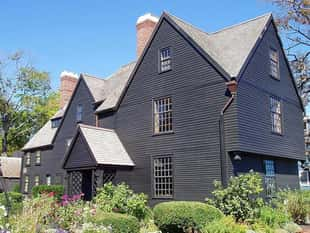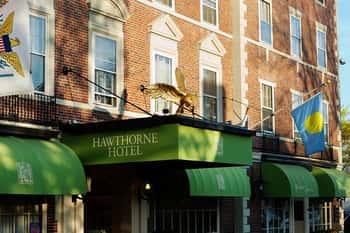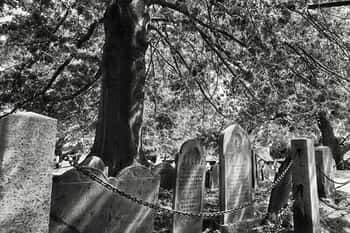is this the most haunted house in Salem?
Do you want to know the most haunted house in Massachusetts? Ask Salem’s locals, and they’ll point to The Merchant. Yet the haunts predate the house itself: the Merchant was built in 1784, though the property has connections to Salem’s Witch Trials of the seventeenth-century. It even occupies the former land of George Corwin, High Sheriff of Essex County. Sound familiar? You may know him better as “The Strangler” of Salem’s Witch Hysteria.
Corwin isn’t the only shadow of Salem’s Merchant, however: Giles Corey, once “pressed to death” by stone, is another occupant.
If you’re into murder and magic, the Merchant is one stop that you’re not gonna wanna miss. Watch out, though – the Merchant isn’t for the skittish.
The Merchant's most infamous association is with the High Sheriff of Salem’s Witch Trials. Yet Sheriff George Corwin wasn’t your run-of-the-mill villain. Instead, Corwin was a sadistic twenty-five-year-old with a reputation for strangulation. But who, exactly, was Sheriff George Corwin? Better yet, what did he do?
Sheriff George Corwin was the nephew of magistrates Jonathan Corwin and Wait Winthrop, yet was also the son-in-law of Judge Bartholomew Gedney. His appointment as High Sheriff of Essex County was an obvious outcome. (If you’re into nepotism, that is.)
Rumor has it that Sheriff Corwin would tie the necks of his victims to their ankles, reinforcing his nickname “The Strangler.” Although this has been unproven, Sheriff Corwin did, however, sign arrest warrants for those convicted of witchcraft. Corwin even chose the execution site of the nineteen who were hanged. His choice? Proctor’s Ledge, visibly situated on the outskirts of Salem.
You can visit Proctor’s Ledge today if you’d like to pay your respects… You may even spot a spirit or two.
Corwin was likewise charged with the transportation of “witches,” carting Rebecca Nurse, Susanna Martin, Elizabeth How, Sarah Wildes, and Sarah Good to Proctor’s Ledge. In Marilynne K. Roach’s Salem Witch Trials Reader, Roach details how Corwin brought Bridget Bishop to her execution:
Like later condemned witches, Bridget Bishop was transported in a cart flanked by guards and mounted officers in a procession that drew onlookers as it passed from the jail, down Prison Lane, to the main street… Several of the afflicted were present, beaten, they said, by old Jacob’s specter, leaning on the Devil so it could use one of its staves as a club.
Through Corwin’s trajectory, Corwin guaranteed that the transportation was public spectacle. Everyone could witness the carrying of Corwin’s convicted “witches.”
Corwin was directly responsible for the arrests of over two-hundred, and the deaths of nineteen. Yet executions weren’t always allowed for witchcraft: a Massasscussttes law that prohibited death by hanging was resurrected and reinstated. Corwin backed the method, no doubt.
Corwin was even ordered by the Court of Oyer and Terminer to oversee the interrogation of Giles Corey. Corey had “stood mute” during trial. His punishment? The “peine forte et dure” – Corwin’s pick. French for “strong and harsh punishment,” the “peine forte et dure” required that the victim’s chest be bound with a board, then set by rock or stone. The method was intended to force the defendant to plead guilty or not guilty. Refuse to plead? Then you were crushed until death. That was the fate of Giles Corey, at least.
Sheriff Corwin was a ruthless executioner, too. When Corey’s tongue had “prest out his mouth” from the “peine forte et dure,” Sheriff Corwin forced it back with his cane. Gruesome? You bet. It’s no wonder that Giles Corey cursed Corwin with the last breath in his body.
Yet Giles Corey was a bit of a fiend himself. Corey had been brought to trial for the murder of Jacob Goodale in 1676. Goodale’s offense? Stolen apples. Corey was exempt from the charge of murder: corporal punishment was permitted against indentured servants, and Goodale had been Corey’s farmhand. Corey was instead convicted for the use of “unreasonable” force. He was obliged to pay a fine but went otherwise unpunished.
Some say that Giles Corey cursed Salem Village during his execution. Since “Corey’s Curse,” The Sheriffs of Salem have since died or resigned for cardiac complications. The Great Salem Fire of 1914 was even attributed to the curse, as well as the premature retirement of Sheriff Robert Cahill. Cahill had been afflicted with a myriad of maladies, though his doctor was unable to determine their cause…
Joshua Ward, Sea Captain and merchant, bought the property in 1784. Ward then had architect Samuel McIntyre build the three-story, Federal-style home in a view of the South River.
Plus, as one of the earliest brick homes in Salem, the property was impressive. So impressive that George Washington requested to stay in the house during his 1789 visit.
A bust of Washington was then placed on a second-floor window, leading passersby to believe that they could spot the spirit of Washington! In this case, though, the “sightings” were more marble than magic.
Yet what makes this eighteenth-century home Salem’s “most haunted”? Is there more to this historic house?
As High Sheriff of Salem’s Witch Trials, Corwin was bound to have a few haunts hidden under the hearth. It’s even alleged that Corwin tortured victims in the “Witch Dungeon,” though this was never proven to be true.
Corwin was, however, buried on the property in 1696. Corwin was only thirty years-of-age, leading some to believe that Corwin surrendered to the curse of Giles Corey. His final cause of death? Cardiac arrest. Strange, since Corey had suffocated while his chest had been set with stone… Corey had only died four years prior, too.
Corwin was later relocated to Broad Street Cemetery, but could his spirit still stalk the house?
Those sensitive to energies seem to think so. And, it’s no surprise that visitors see the Sheriff sitting near the fireplace! The Salem Pioneer even detailed that “another sighting, that of the sheriff himself” was said to have been witnessed by the Merchant’s former establishment.
Legend has it that you can feel “The Strangler’s” suffocating grip. ”Apparition asphyxiations? No place for the fearful or faint of heart!
There are those who say that Giles Corey inhabits The Merchant. Some blame Corey for knocking over candlesticks. Trash cans are overturned, items found out of place, deadbolts open and close on their own… Does Corey seek revenge against Salem, or retribution? Is this Corey’s penance for the death of Jacob Goodale? – Or is Corey lashing out at Sheriff Corwin, whose company he’s forced to keep?
The Merchant’s most peculiar spectacle must be that of the “Lady in Black. ” No one’s sure what she wants, or where she came from, but they all have similar sightings: a female spirit in a black costume with blacker curls. “The Lady in Black” has even been described as having transparent skin. It’s as if she were made of glass!
Fun Fact: Photos were taken of “The Lady in Black,” showing a full-length figure with unbrushed hair. The photo, taken by Carlson Realty in the 1980s, was intended to capture an employee. Yet Carlson Realty caught something else altogether… Robert Cahill highlighted the image in his New England’s Ghostly Haunts, and other witnesses have since corroborated the event.
Some believe that “The Lady in Black” was another victim of Corwin’s, though her identity is unknown. Let us know if you see her? Or if you find out more!
The Merchant wasn’t always known by its moniker. In the nineteenth century, the Merchant was instead The Washington Hotel! Was this inspired by Washington’s visit or its location on Washington Street? Either way, its namesake was appropriate.
By the twentieth century, the Merchant became a real estate center, publishing company, and multi-unit office space. Employees of the former Higginson Book Company say they've certainly seen their fair share of spirits!
The Merchant was even set for demolition in the 1970s, though it was later saved. We imagine we’re not the only ones thankful, however… There are a few pleased phantoms, too.
Want more of Giles Corey? Be sure to stop by Howard Street Cemetery! It’s said that his ghost still gallivants across the graveyard. And, as Salem’s fourth oldest burning ground, you’re bound to find a few phantoms. You can also find a monument to Giles Corey at Proctor’s Ledge, the confirmed site of execution for Salem’s Witch Trials. Located at Pope Street, Proctor’s Ledge memorializes those lost to Salem’s unjust bigotry. You can even stop by the Salem Witch Trials Memorial!
Although the Merchant discourages paranormal investigations, their rooms are available for booking. Stay for a spell, or maybe a spook? The Merchant is also a five-minute walk from the Salem Train Station and the Peabody Essex Museum, making it a prime location for a wayside wander! Report back to us if you find any paranormal activity, of course.
You can book a room at the Merchant by visiting their website.

One of Salem's most famous haunted houses

Spend a night in Salem's most haunted hotel

One of Salem's haunted Cemeteries